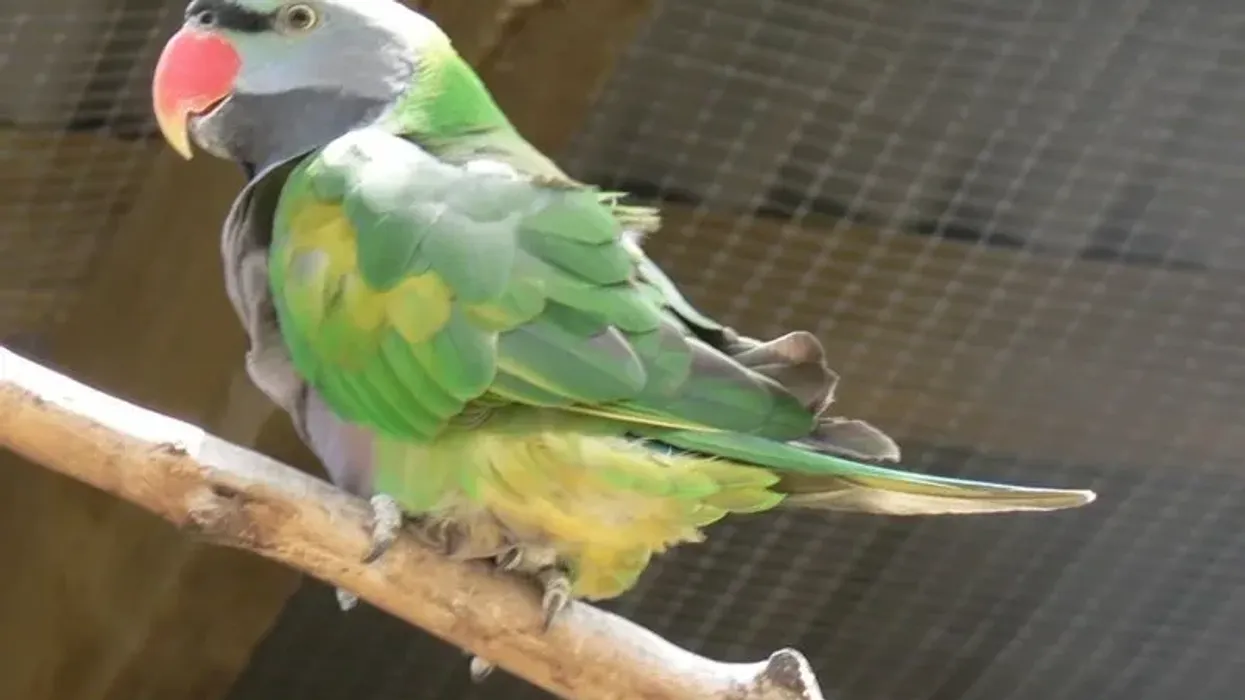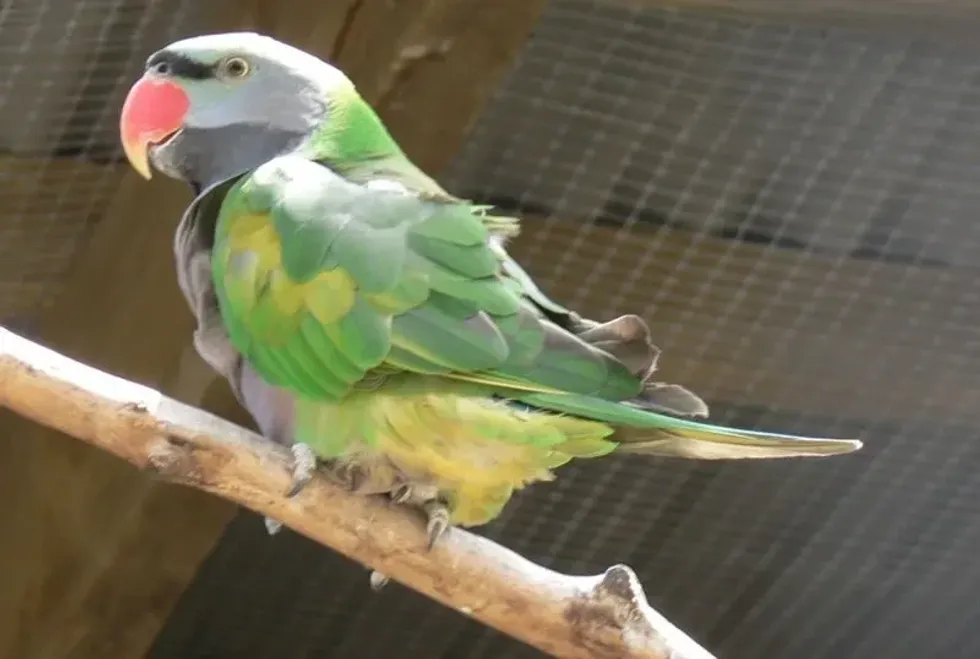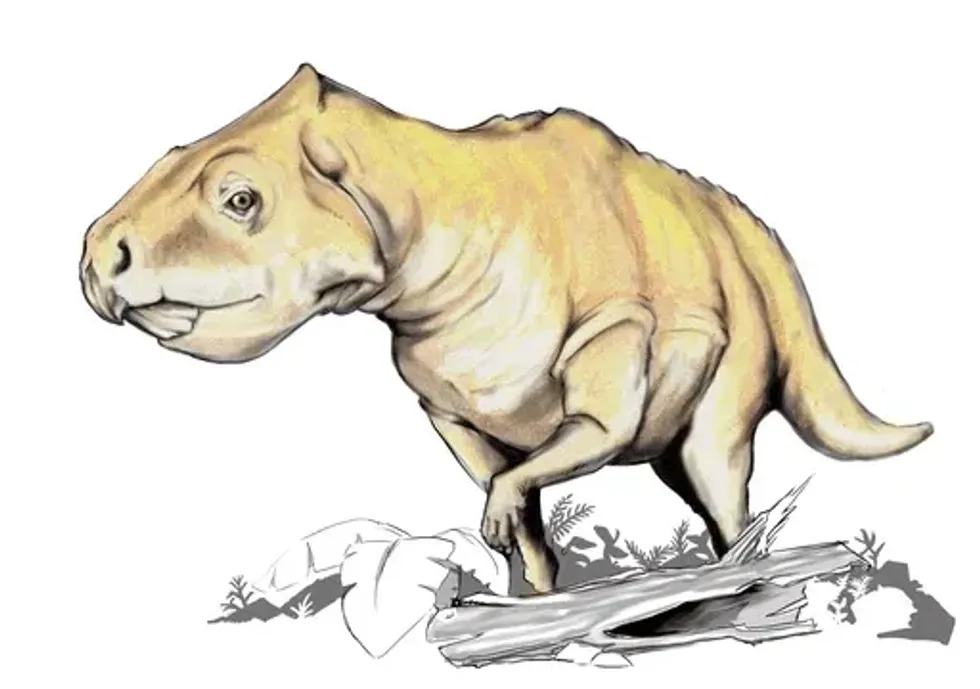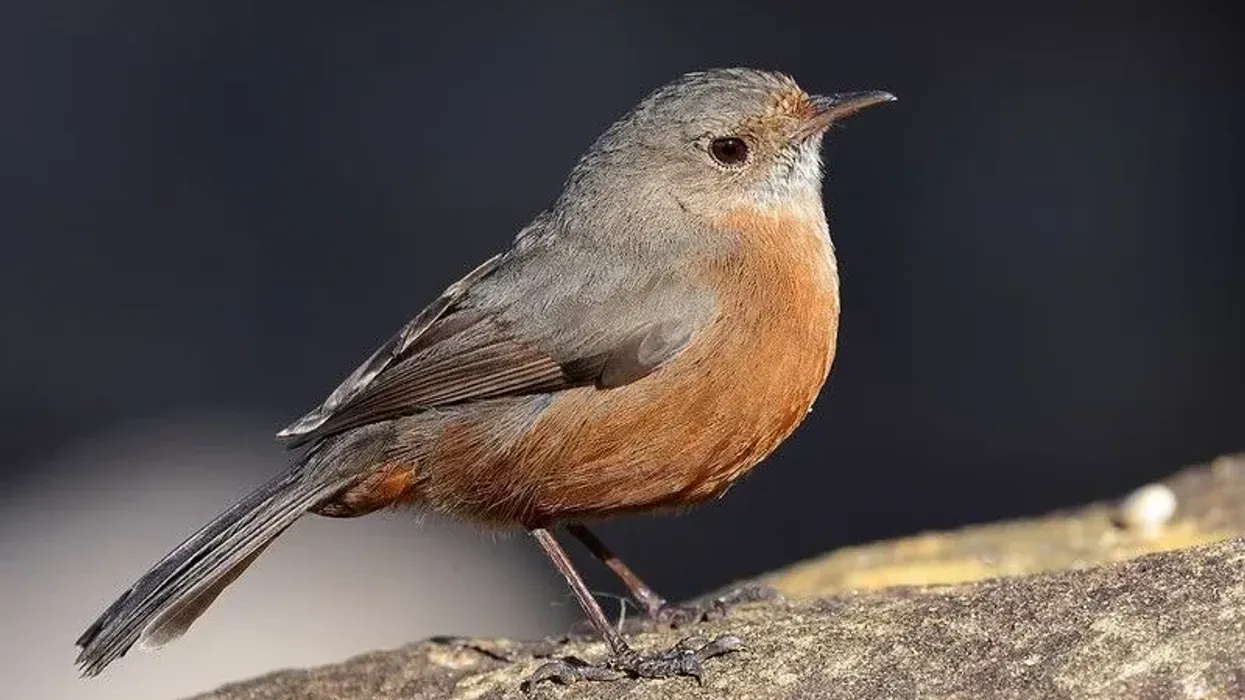Fun Derbyan Parakeet Facts For Kids
Do you like hearing the chirping sounds and sweet mimics of your pet in your home? Then, why not try getting a Derbyan parakeet. You would for sure love the cherished nature of this friendly and loving friend.
The Lord Derby's parakeet, also known as the Derbyan parakeet, is a strikingly beautiful and obedient pet parrot. These parakeets have black streaks and unusual color variations, making them one of the most eye-catching parrots around.
Parakeets are loved for their cool and playful personalities. They'll easily become a caring companion. They have a loud voice and can be very noisy, but they are quieter when held alone and given plenty of attention.
If you are on the search for this bird, let us help you where these birds are found! The Derbyan parakeet is native to the Himalayan subalpine conifer forests of north-eastern India, south-eastern Tibet, and southern China, where it can be found in the Himalayan sub-alpine conifer forests. Scroll down to learn more about this talking bird.
You may check other interesting articles on the Carolina parakeet and monk parakeet.
Derbyan Parakeet Interesting Facts
What type of animal is a Derbyan parakeet?
The Derbyan parakeet, also known as Lord Derby's parakeet, is a beautiful parrot. Parakeets belong to the parrot family as a whole. Compared to larger parrots, they typically have tapered and long tail feathers and a less stocky body.
A parakeet may be a small budgerigar or a larger species with a longer lifespan and adapted to a different environment. A parakeet as a taxonomic group has no standard definition; it is part of a larger group that includes hundreds of birds, and the Derbyan parakeet is one of them.
The debate about whether to get a parrot or a parakeet is never-ending. Parakeets are all classified as parrots; however, not all parrots are parakeets.
What class of animal does a Derbyan parakeet belong to?
Derbyan parakeets belong to the Aves class and Psittacula genus. The scientific name of Derbyan parakeets is Psittacula derbiana.
How many Derbyan parakeets are there in the world?
The exact number of Derbyan parakeets is unknown. However, there are around 100 different varieties of parakeets in the world today. According to some estimates, over 40 million pet parakeets live in different parts of the world right now, from the United States and the United Kingdom to South Africa.
Where does a Derbyan parakeet live?
The Derbyan parrots are found in northeast Assam, southeast Tibet, and Sichuan and Yunnan provinces of western China.
What is a Derbyan parakeet's habitat?
The Derbyan parakeet (Psittacula derbiana) is a mountain bird that lives in pine and oak forests and alpine rhododendron forests. These bird species are native to India's and Tibet's hilly and mountainous terrains and in Sichuan and Yunnan provinces, China. However, since ornithologists seldom visit this region, little is known about their habits.
Who do Derbyan parakeets live with?
Derbyan parakeets are very social and live in small flocks of up to 50 birds in the wild. This parrot species seems to favor birds as companions and may seem aloof, avoiding human contact. They usually have a calm demeanor and make great aviary birds, but they can get noisy sometimes, especially when bored.
How long does a Derbyan parakeet live?
The Derbyan parakeet has a life span of up to 30 years of age. These birds can become stable, healthy, long-lived, and good-natured pet parrots with proper care, patience, and attention.
How do they reproduce?
Derbyan parakeets reach maturity around the age of two. They are excellent parents and can readily breed in captivity. The breeding season for this bird species normally starts in April and lasts until June.
Derbyan parakeets fly in flocks of 40-60 birds, mating for the breeding season. In tree nest holes, the female lays a clutch of two to four eggs. This parrot species raise their chicks in tree hollows until they're ready to leave the nest - roughly eight to nine weeks after the chicks' incubation time.
Working with Derbyans is much more difficult than working with other Asiatic parrots. When breeding, these larger Derbyan Asiatic parrots need a lot of privacy. Even though these parrots achieve maturity at about three years of age, most breeders believe that mature birds of five years of age or more are the best for breeding.
What is their conservation status?
Although these birds nest in remote locations, they are still an endangered species. Poaching for the illicit wildlife trade is a problem for Lord Derby's parakeet, which commands a high price on the black market.
Poaching and illegal trade pose the greatest threats to their survival, as does forest clearing, which disrupts their breeding habits.
In mainland Asia, it is possibly the rarest of all Psittacula species. As a result, the status of this bird was upgraded from Least Concern to Near Threatened in the 2011 IUCN Red List of Threatened Species.
Derbyan Parakeet Fun Facts
What do Derbyan parakeets look like?
Derbyan parakeets are sexually dimorphic, which means the two sexes have different colors and markings and different organs. When it comes to coloration, these parakeets are among the most interesting.
Their lower cheeks are black, with a bright blue forecrown that fades into a blue-violet for the rest of the head. They have green on the thighs and vent area, with blue on some of the feather edges, while lavender-purple on the throat, underparts, and under the wings.
The tail's central feathers are blue with a hint of green at the base, while the outer feathers are green.
This bird's eye is yellowish-white in color, and the legs are a grayish-green color. Its black facial stripes distinguish the Derbyan parakeet.
The beak of the female and male Derbyan parakeet vary significantly in appearance, with females having an all-black beak and the upper beak of the male has a yellow tip, and the lower mandible is black. Not only can the female be distinguished with an all-black beak, but she also lacks the blue on the forecrown.
A brownish pink band behind the ear coverts also distinguishes her.
The young are paler in color and have a greenish-blue head. The eyes are black, and the beak is orange-red. They can hit adult coloring when they are around two years old.

How cute are they?
The Derbyan parakeets can be synonymous with cuteness. These parakeets are among the most interesting with their green, yellow, blue, orange, black shades when it comes to coloration.
Green dominates the wings, neck, legs, and back, while a purplish-gray dominates the abdomen, chest, and heads. The female bird has an all-black beak, while the male has a rosy redone, giving them a slightly grumpy appearance.
Mimicking, being playful, and lots of interaction with people make this bird ever cuter. This parrot is so cute that you can't resist taking photos with this bird.
Are you curious to know the rarest color of this bird species? Anthracite, a super dark charcoal color, is a scarce color in this intelligent bird species, and Texas's clear body is extremely rare, as is Fallow, lacewing.
How do they communicate?
In flight, this bird species makes raucous, noisy, and metallic sounds. Their vocalizations are similar to those of crows and ravens. However, contact calls go a long way. Derbyan parakeets live in small flocks of up to 50 birds in the wild and are very social.
The Derbyan parakeet is also a competent talker, despite its usually not so noisy nature. These intelligent parrots will have a limited vocabulary and repeat the words, sounds, and phrases they hear the most.
How big is a Derbyan parakeet?
The Derbyan parakeet is a large breed, with adults ranging between 18-20 in (45–50 cm). The average size this healthy adult bird grows is 20 in (50 cm). Thus, its size is comparable to that of the common Alexandrine parrot.
How fast can a Derbyan parakeet fly?
While the exact flying speed of the Derbyan parakeet is not known, most parrots can fly at speeds of 40-50 mph (64.4-80.5 kph), with some species flying much faster or slower. Parakeets are very active birds!
How much does a Derbyan parakeet weigh?
The average weight an adult parakeet Lord Derby's grown is 11.2 oz (320 g). Therefore, when compared to other parakeets, Derbyan parakeets are larger.
What are the male and female names of the species?
The male and female bird species do not have any specific names. However, they are known as male parakeets and female parakeets.
What would you call a baby Derbyan parakeet?
The baby of a Derbyan parakeet is not given any specific name. Instead, they are called a baby or a young parakeet. The clutch size of this parrot is two to four eggs.
What do they eat?
The Derbyan parakeets feed on a variety of seeds, fruits, berries, and leaf buds in the wild. They fly around in search of fresh food and water.
A healthy portion of fresh fruits and green vegetables should be added in addition to the normal seed mixes for this bird. Another thing to note is to refill their fresh drinking water regularly.
Are they dangerous?
The Derbyan parakeet is more placid than many other parakeets, but it is still very active and destructive. To avoid boredom, this highly intelligent bird needs a lot of stimulation.
Provide your pet with plenty of treats, toys, wood chews, perches, and swings, as well as regular time out of its cage. On the whole, the parakeets are not dangerous.
Would they make a good pet?
A Derbyan parakeet is a perfect pet. This lovely bird will easily become an affectionate and calm pet, with more than a few tricks and mimics up its sleeve, once it has become accustomed to you and comfortable in its new home.
A large cage is required, and they need time out of the cage for exercise and flight. Cleaning the water and food dishes on a regular basis is part of simple cage maintenance. All of the perches and dirty toys should be washed weekly, and the floor should be washed every other week or so.
Taking care of a Derbyan parakeet necessitates a lot of one-on-one time. Plenty of interaction is required to maintain the tameness of this bird. They enjoy learning new vocabulary and phrases and playing with toys. They need a lot of toys and other interesting items, as well as a lot of contact with their caregivers.
As for all birds, have fresh water regularly in addition to a balanced diet, and avoid foods that are poisonous to birds, such as avocado and chocolate.
Did you know...
Did you know that apart from flying, which is important for all parakeets, these birds also enjoy chewing!
Parakeets puff up to preserve their body heat. Birds fluff up their feathers to catch as much air as possible. The colder they are, the more air they trap.
Do you think your parakeet is scared and want to know why? Parakeets sometimes can get scared of cats and dogs at home. Some birds are afraid of being touched and will hide in their cage. Coming from an abusive home also could make your budgie fearful.
The dark is a fearful place for many parrots. Cockatiels, in particular, are susceptible to night frights. When your bird flaps and flails inside and outside its cage at night, this is known as night fright.
What is the most common parakeet?
Melopsittacus undulatus, the Australian budgerigar, also known as budgie, is the most common parakeet. It is the most common species of parakeet kept as a pet in North America and Europe.
Do Derbyan parrots talk?
Among the parakeets, the Derbyan is one of the best talkers. They are highly intelligent and can learn a large number of vocabulary, speaking clearly in a manner close to amazon parrots.
Derbyan parakeets can go from babbling to competent speech and have even been known to form complete sentences when properly educated. They will use acceptable sentences to let you know when they want to sleep, eat, or play.
They may become noisier than normal if they aren't given much attention and are usually ignored. Interaction with this bird will surely make your day.
Here at Kidadl, we have carefully created lots of interesting family-friendly animal facts for everyone to discover! Learn more about some other birds from our crane facts and European robin facts pages.
You can even occupy yourself at home by coloring in one of our free printable derbyan parakeet coloring pages.
We Want Your Photos!
More for You
See All
Bachelor of Science specializing in Microbiology

Oluwatosin MichaelBachelor of Science specializing in Microbiology
With a Bachelor's in Microbiology from the Federal University of Agriculture, Abeokuta, Ogun State, Oluwatosin has honed his skills as an SEO content writer, editor, and growth manager. He has written articles, conducted extensive research, and optimized content for search engines. His expertise extends to leading link-building efforts and revising onboarding strategies.
Disclaimer
1) Kidadl is independent and to make our service free to you the reader we are supported by advertising. We hope you love our recommendations for products and services! What we suggest is selected independently by the Kidadl team. If you purchase using the Buy Now button we may earn a small commission. This does not influence our choices. Prices are correct and items are available at the time the article was published but we cannot guarantee that on the time of reading. Please note that Kidadl is a participant in the Amazon Services LLC Associates Program, an affiliate advertising program designed to provide a means for sites to earn advertising fees by advertising and linking to Amazon. We also link to other websites, but are not responsible for their content.
2) At Kidadl, we strive to recommend the very best activities and events. We will always aim to give you accurate information at the date of publication - however, information does change, so it’s important you do your own research, double-check and make the decision that is right for your family. We recognise that not all activities and ideas are appropriate for all children and families or in all circumstances. Our recommended activities are based on age but these are a guide. We recommend that these ideas are used as inspiration, that ideas are undertaken with appropriate adult supervision, and that each adult uses their own discretion and knowledge of their children to consider the safety and suitability. Kidadl cannot accept liability for the execution of these ideas, and parental supervision is advised at all times, as safety is paramount. Anyone using the information provided by Kidadl does so at their own risk and we can not accept liability if things go wrong.
3) Because we are an educational resource, we have quotes and facts about a range of historical and modern figures. We do not endorse the actions of or rhetoric of all the people included in these collections, but we think they are important for growing minds to learn about under the guidance of parents or guardians.







